Bridges are more than just engineering marvels—they are lifelines that connect cities, villages, and even entire nations. Yet, some bridges around the globe test the limits of human courage, engineering resilience, and natural endurance. From the icy wilderness of Siberia’s Kuandinsky Bridge to the bamboo-built Monkey Bridges of Vietnam, these precarious crossings are as fascinating as they are frightening. Suspended over raging rivers, deep valleys, and glacier-fed lakes, the world’s most dangerous bridges blend history, culture, and extreme risk, attracting both locals who depend on them for survival and thrill-seekers chasing adrenaline.
Here are top most Dangerous Bridges in the World:
20. Quepos Bridge, Costa Rica
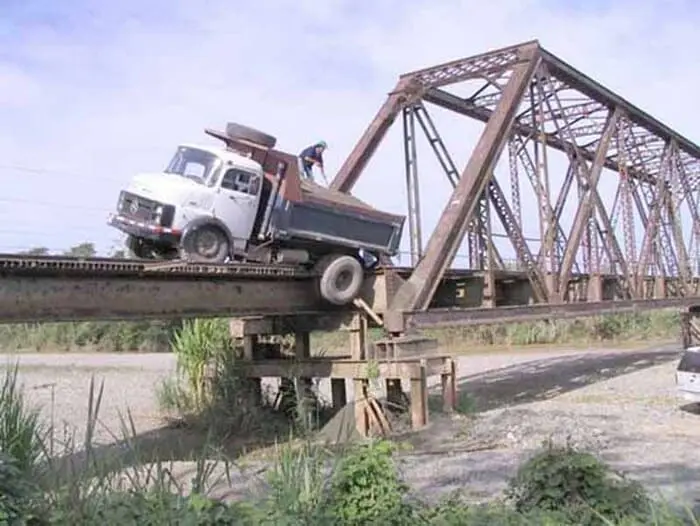
The Quepos Bridge—locally infamous as the “Bridge of Death” or the “Oh My God Bridge”—is one of the most dangerous bridges in the world, located on the road connecting Jacó to Quepos in Costa Rica’s Central Pacific region. Originally constructed in the 1930s–1940s by the Bananera Company for transporting banana trains, this narrow crossing stands as a relic of industrial history.
The bridge is built from wooden planks and designed with an extremely limited width, restricting vehicles to one-way passage. Despite its fragile appearance, the Quepos Bridge continues to support local traffic, including trucks weighing up to 30 tonnes—a remarkable contrast to its seemingly inadequate structure. Cyclists can barely fit across the span, yet it remains a lifeline for daily transportation.
Adding to its notorious reputation, the bridge’s loose wooden slats rattle noisily under pressure, while the entire structure visibly trembles with each crossing. These unnerving conditions, combined with its historic yet decaying design, solidify the Quepos Bridge’s status as one of the most perilous bridges still in use today, both a cultural landmark and a hazardous route in Costa Rica.
19. Storseisundet Bridge, Norway

The Storseisundet Bridge is a striking cantilever bridge located on the Atlantic Road (Atlanterhavsveien) along Norway’s western coast in Møre og Romsdal county. As the longest of the Atlantic Road’s eight bridges, it has become the roadway’s most iconic architectural landmark and a globally recognized example of daring bridge engineering.
From Møre og Romsdal’s coastal vantage points, the roadway’s 8% gradient and 21° convex arc merge with the Norwegian Sea horizon, spawning the viral optical illusion that the cantilever span free-falls into open ocean.
This disorienting visual effect has earned it vivid nicknames, including the “drunk bridge” and the “bridge that disappears.”
This visual cliff effect—amplified by winter hurricane swells crashing over the parapet—earned the 1989 structure the nicknames “disappearing bridge”, “drunk bridge”, and Daily Mail’s 2011 headline “road to nowhere”. Despite its heart-stopping appearance, the reinforced-concrete Storseisundet remains one of the world’s scariest-looking yet structurally sound coastal bridges, luring thrill-seeking drivers to Norway’s National Tourist Route 64.
18. Hanging Bridge of Ghasa, Nepal
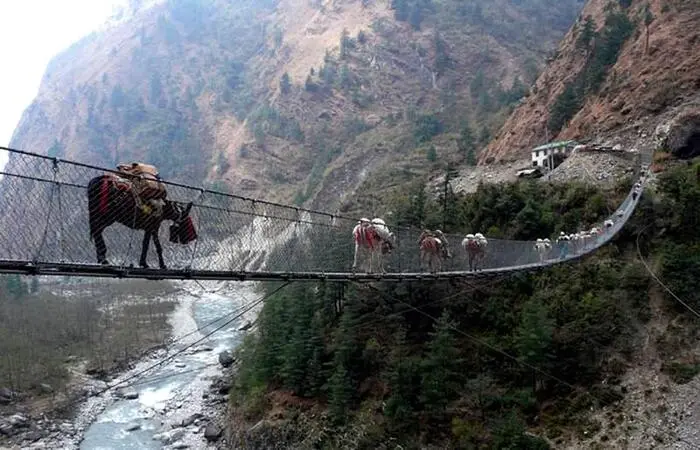
The Ghasa Suspension Bridge, situated near the village of Ghasa in Nepal’s Mustang District, is a pedestrian suspension bridge that spans a deep river gorge in the Himalayan region. Known for its narrow design and its tendency to sway with the wind, the bridge has earned a reputation as both an intimidating crossing for outsiders and a critical lifeline for local communities.
The 1.2 m-wide deck, lattice sidewalls, and wind-induced lateral swing create a high-altitude adrenaline spike for trekkers on the Annapurna Circuit, yet Thakali herders steer yak and cattle caravans across the same span daily.
For many visitors, the oscillating motion of the bridge creates a sense of danger, reinforcing its place among the world’s most intimidating suspension bridges. Yet, for the local population, the Ghasa Suspension Bridge is a trusted and reliable structure, routinely used with confidence by both people and animals. This contrast between perceived danger and practical necessity makes it a unique and compelling example of the world’s dangerous yet indispensable bridges.
17. Musou Tsuribashi Bridge, Japan

The Musou Tsuribashi Suspension Bridge, often referred to as “Japan’s Scariest Suspension Bridge,” is a narrow and precarious pedestrian footbridge hidden deep in the Southern Japanese Alps (Akaishi Mountains). Built in the 1950s, it remains one of the oldest suspension bridges in Japan still in active use, and its reputation for danger has made it an infamous landmark among adventurous travelers.
The bridge is supported primarily by wire cables and features a wooden plank walkway that stretches across a steep and rugged mountain valley. Its setting on the inclined slopes of the Akaishi Mountains makes access challenging—reaching the bridge requires hikers to ascend a steep trail aided by metal chains, as the gradient is too dangerous to climb unaided.
Despite its intimidating appearance, the Musou Tsuribashi was originally constructed to serve isolated local communities in this remote mountain region, providing vital pedestrian connectivity where no roads could exist. The bridge’s thin structure and tendency to sway in strong winds amplify its reputation as one of the most dangerous suspension bridges in the world. Yet, its enduring functionality for over half a century highlights the resilience of traditional Japanese suspension bridge engineering in challenging alpine environments.
16. Sidu River bridge, China
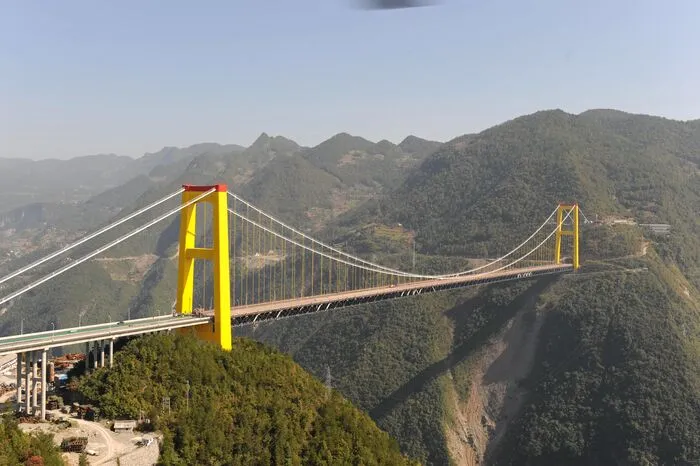
The Sidu River Bridge, located near Yesanguan town in Badong County, Hubei Province, China, is one of the most remarkable and intimidating suspension bridges in the world. When it opened in November 2009, it held the record as the world’s highest bridge, with its deck rising approximately 496 meters (1,627 feet) above the Sidu River Valley.
Spanning a dramatic and remote gorge, the bridge presented extraordinary construction challenges. Traditional methods of laying the pilot cable, such as using helicopters or boats, were impossible due to the valley’s steep and inaccessible terrain. Instead, engineers employed a groundbreaking solution: they fired a rocket across the gorge to carry the pilot cable, a world-first in bridge engineering.
The Sidu River Bridge features a steel structure supported by concrete towers and a truss-stiffened roadway, stretching 1,222 meters (4,009 feet) in total length with a main span of 900 meters (2,952 feet). Built at a cost of approximately US $100 million, the bridge is both an engineering marvel and an awe-inspiring experience for travelers crossing its high deck, especially for those with a fear of heights.
Although it lost its title as the world’s highest bridge in 2016 to the Duge Bridge, the Sidu River Bridge remains one of the most dangerous-looking and breathtaking bridges on Earth, celebrated as a symbol of modern Chinese engineering achievements and a landmark in suspension bridge innovation.
15. U Bein Bridge, Myanmar
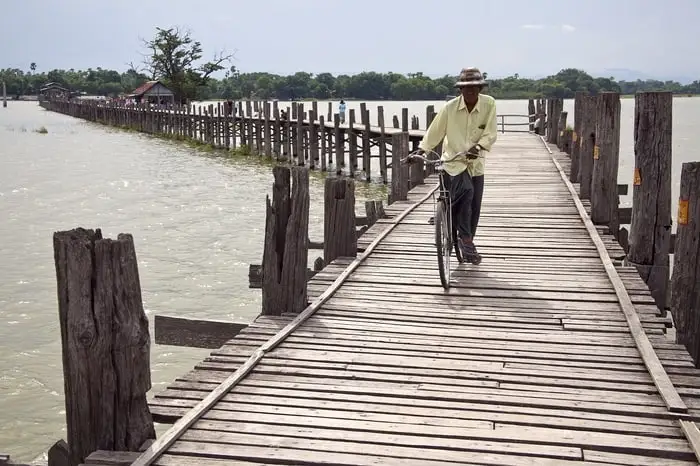
The U Bein Bridge, located near Amarapura in Myanmar, holds the distinction of being the world’s oldest and longest teakwood bridge. Constructed between 1849 and 1851 under the direction of Maung Bein (U Bein), then the mayor of Amarapura, the bridge was built using teak wood reclaimed from the former royal palace of Inwa, which had deteriorated over time.
Stretching approximately 1.2 kilometers (0.75 miles) across Taungthaman Lake, the bridge rests on more than 1,000 wooden pillars, though many have been replaced with concrete supports to improve structural stability. Despite these reinforcements, the absence of guardrails makes the U Bein Bridge a precarious crossing, where both locals and tourists are urged to exercise caution.
The bridge is celebrated for its historic design and scenic setting, particularly during sunrise and sunset, when it becomes one of Myanmar’s most photographed landmarks. It serves as a vital pedestrian route for monks, vendors, fishermen, and the surrounding community, while also drawing global travelers seeking an authentic cultural experience.
Yet, the U Bein Bridge also faces significant threats. Decades of exposure to floods, termites, and natural erosion have caused extensive decay of the original teak pillars, with some now detached and supported only laterally. These structural vulnerabilities contribute to its classification among the world’s most dangerous bridges, where age, design, and wear amplify the sense of risk.
Preservation initiatives, led by Myanmar’s Ministry of Culture, are ongoing, balancing the need for restoration and modernization with the goal of maintaining the bridge’s historic authenticity. As both a UNESCO-recognized cultural heritage site candidate and a symbol of Myanmar’s history, the U Bein Bridge endures as a unique intersection of beauty, danger, and tradition.
14. Eshima Ohashi Bridge, Japan

The Eshima Ohashi Bridge, often nicknamed “Japan’s Rollercoaster Bridge,” is a massive rigid-frame concrete bridge renowned for its dramatic and seemingly perilous design.
Measuring approximately 1.7 kilometers (1.06 miles) in total length, the bridge reaches a height of 45 meters (148 feet) at its peak, enabling large ships and cargo vessels to pass freely beneath. What makes the Eshima Ohashi Bridge world-famous is its steep incline—with a slope of about 6.1% on the Shimane side and 5.1% on the Tottori side. When viewed from certain angles, particularly through telephoto photography, the bridge creates the dramatic optical illusion of a near-vertical ascent, reinforcing its reputation as one of the most intimidating bridges in the world.
Shot head-on with a telephoto, the steep Shimane-side grade collapses perspective into a near-vertical wall; in real life the slope is drivable in top gear, yet the visual punch still spikes adrenaline. Built 1997-2004 to kill the old bascule’s traffic jams, the world’s third-largest rigid-frame span now doubles as an earthquake-proof highway and a must-frame landmark for cyclists hunting that “we’re-going-straight-into-the-sky” Instagram reel.
Today, the Eshima Ohashi Bridge stands as the largest rigid-frame bridge in Japan and the third-largest of its kind in the world.
13. Kuandinsky Bridge in Kuanda, Russia
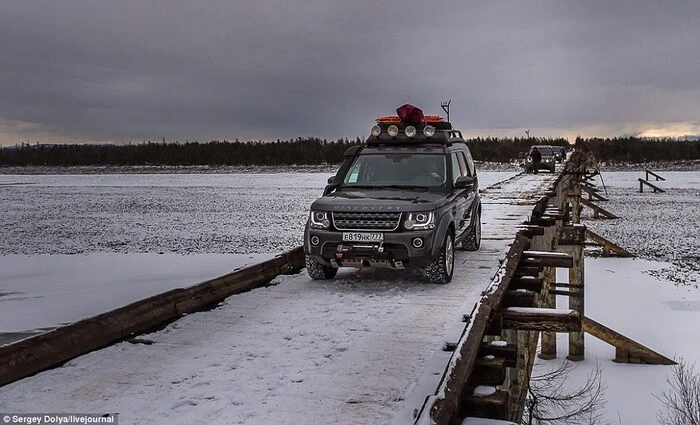
The Kuandinsky Bridge, located in Russia’s Trans-Baikal Region, is one of the narrowest and most dangerous roads in Siberia, spanning the icy waters of the Vitim River. Originally built as part of the ambitious yet unfinished Baikal–Amur Mainline (BAM) railway project, the bridge extends approximately 570 meters (1,870 feet) in length but measures just over two meters (about six feet) in width.
With no guardrails or safety barriers, it poses a constant danger to anyone attempting to cross, whether on foot or by vehicle.
The structure is composed of aging iron supports and a surface lined with wooden railway sleepers, remnants of its abandoned railway purpose. Over decades without significant maintenance, these planks have deteriorated, becoming slippery hazards during Siberia’s long winters. Snow, ice, and strong crosswinds intensify the danger, often forcing drivers to roll down their windows to reduce wind resistance while inching across the this icy cold dangerous place.
From October to April those planks turn into a polished luge track; Siberian cross-winds slam the gorge so hard that drivers drop windows to keep the gust from shoving them through the open edge.
Despite its daunting conditions, the Kuandinsky Bridge remains a lifeline for the nearby village of Kuanda, providing a vital, though dangerous, connection across the Vitim River. It has also earned global attention as a proving ground for daredevil drivers and thrill-seekers, who view crossing the bridge as an ultimate test of courage.
Zero official crashes are on record—proof that terror, not speed limits, keeps the fatality count at nil.
12. Puente de Ojuela, México
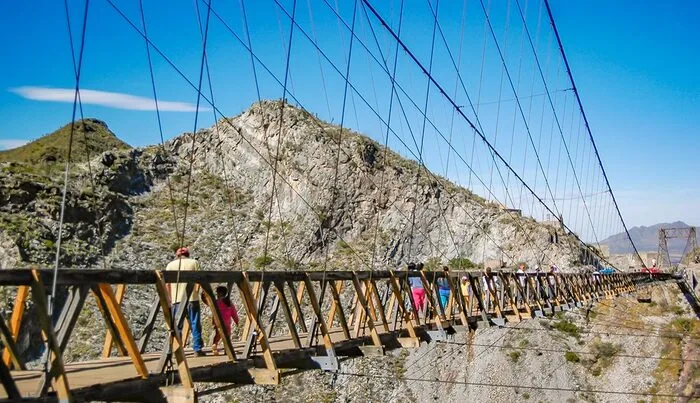
The Puente de Ojuela, located in Mexico, is a narrow suspension bridge that offers one of the most thrilling and unnerving crossings in the world. Measuring just 2 feet (0.6 meters) wide, it stretches about 318 meters (1,043 feet) across a deep ravine and rises nearly 110 meters (360 feet) above the valley floor. Its open framework and creaking wooden planks create a dizzying sense of exposure with every step.
Built in 1898 by German engineers descended from the Roebling family—the designers of the Brooklyn Bridge—the Puente de Ojuela was originally constructed to link the ghost town of Ojuela with its gold and silver mine. At the time, it ranked among the longest suspension bridges in the world. Reinforced with steel cables in modern times, it now functions primarily as a tourist attraction, drawing visitors fascinated by both its history and its fear-inducing height.
The surrounding ghost town, once a thriving mining community, now lies in ruins, with crumbling buildings that echo the past. Crossing the bridge evokes both awe and apprehension due to its height, narrow walkway, and the open framework allowing views straight down to the ravine below.
11. Canopy Walk, Ghana

The Canopy Walk in Ghana’s Kakum National Park is a thrilling way to explore the rainforest from a unique vantage point approximately 40 meters (130 feet) above the forest floor. The walkway consists of seven suspension bridges connected between tall trees, spanning a total length of about 350 meters (1,150 feet). This elevated trail offers visitors an exciting and somewhat challenging experience, providing close encounters with the forest canopy, including views of trees, birds, monkeys, and other wildlife.
Despite its tropical location, the Canopy Walk was designed and built in the 1990s with the help of Canadian engineers alongside Ghanaian experts. The structure is made of wire rope, aluminum ladders, and wooden planks, secured safely with netting to prevent accidents while allowing the natural environment to flourish. The walk is not recommended for those with a fear of heights due to the suspension bridges’ movement and elevation.
The Kakum Canopy Walk is one of only a few such rainforest walkways in Africa and is a highlight of ecotourism in Ghana, attracting many visitors who seek adventure and a chance to see rare flora and fauna from a canopy-level perspective.
10. Suspension Bridge on the Trift Glacier, Switzerland
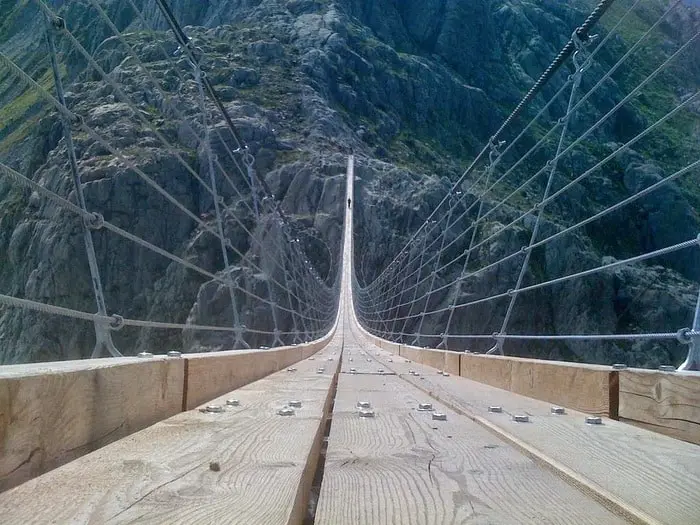
The Trift Bridge is one of the most spectacular pedestrian suspension bridges in the Swiss Alps. It spans approximately 170 meters (558 feet) in length and hangs about 100 meters (328 feet) above the turquoise waters of Triftsee, a lake formed by meltwater from the retreating Trift Glacier. The bridge offers breathtaking views of the glacier region and surrounding alpine cliffs, providing a thrilling experience for visitors.
For those who enjoy adventure, crossing the Trift Bridge is an exciting challenge comparable to mountain climbing or other adrenaline-inducing activities. Accessing the bridge involves a scenic cable car ride followed by a roughly 90-minute uphill hike, which can be steep and demanding.
The cliffs overlooking the glacier and lake add to the dramatic landscape, making this hike both challenging and incredibly rewarding. Visitors are advised to be prepared for variable weather and to take safety precautions while crossing due to the bridge’s height and suspension design.
The current bridge, completed in 2009, replaced an earlier, less stable structure built in 2004 to improve safety and accommodate the increasing number of tourists drawn to this remote alpine area.
9. Carrick-a-Rede Rope Bridge, Northern Ireland
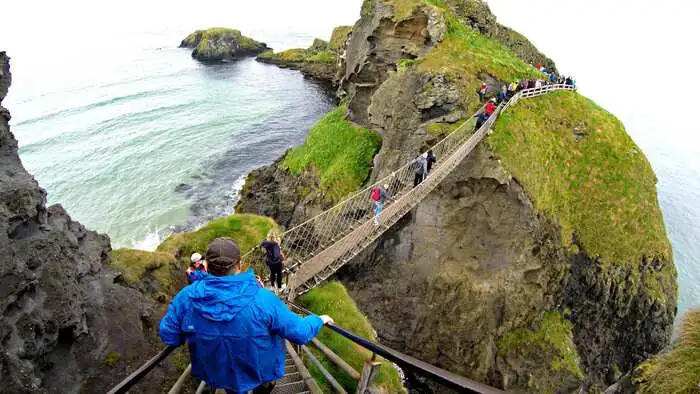
The Carrick-a-Rede Rope Bridge creates a dramatic sense of exposure because it is suspended 30 metres above the rocks and sea and sways when people cross, but modern engineering makes it very safe for visitors. Structural upgrades and strict safety measures—including regular closures during bad weather and staff managing foot traffic—ensure that most risks are minimized, although those afraid of heights or unsteady on their feet may still find the crossing psychologically challenging. There have been no major accidents in recent years, but visitors must follow all rules and walk carefully, since a mis-step could result in minor injury.
8. Monkey Bridges, Vietnam
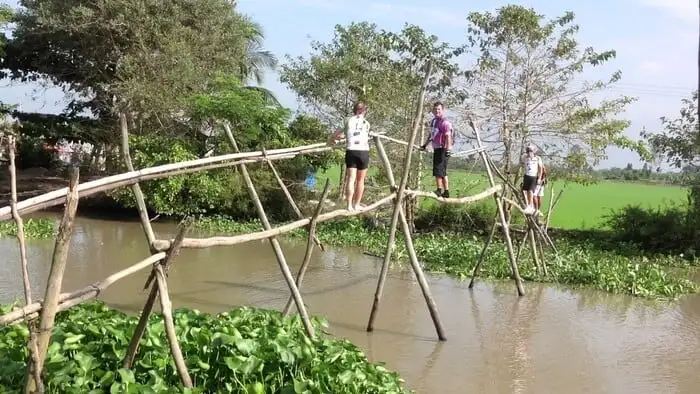
Monkey Bridges (locally called cầu khỉ) are traditional handmade footbridges found across rural Vietnam, especially in the Mekong Delta. Typically built from a single bamboo log or narrow wooden plank, with only a basic bamboo or wooden handrail, these bridges demand balance and agility. Their name comes from the crouched posture required to cross, resembling the movements of a monkey, as one misstep could lead to a fall into the river or canal below.
Constructed by local villagers using readily available bamboo and wood, Monkey Bridges serve as vital pedestrian links between remote villages, rice fields, and local markets. While many have been replaced by modern concrete bridges, they remain enduring cultural symbols of Vietnam’s rural life and resourcefulness.
Internationally recognized for their difficulty and danger, Monkey Bridges have been ranked among the world’s scariest bridges by outlets such as Travel + Leisure and Top Ten Things. Their extreme narrowness, height above waterways, and rustic design make crossing them both intimidating and exhilarating, especially for tourists unaccustomed to this traditional form of passage.
7. Aiguille du Midi Bridge, French Alps
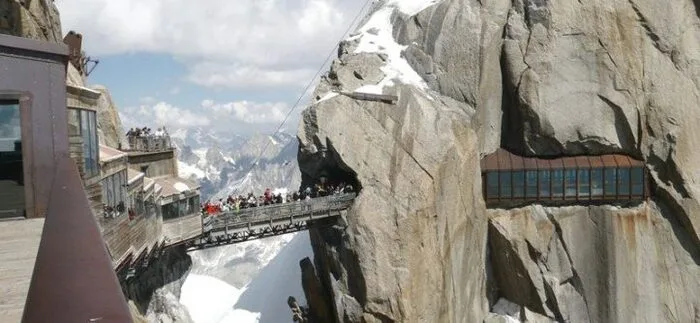
The Aiguille du Midi footbridge, though relatively short, offers an extraordinary experience due to its incredible altitude and spectacular surroundings. Located at an elevation of 3,777 meters (12,388 feet) in the Mont Blanc massif within the French Alps, the bridge connects the cable car station to a viewing platform and offers breathtaking panoramic views of Mont Blanc and the surrounding peaks.
To reach this dramatic vantage point, visitors take a famous two-stage cable car ride from the town of Chamonix, ascending from about 1,035 meters (3,396 feet) to the Aiguille du Midi station at 3,777 meters—a vertical climb of over 2,700 meters (9,200 feet), which is the highest vertical ascent cable car in the world. The cable car journey itself is an exhilarating experience, offering stunning views of glaciers, cliffs, and alpine terrain.
Once at the top, visitors can cross the small footbridge, which is perched at high altitude, providing a breathtaking and vertigo-inducing view of the Alps. For those brave enough to face the heights, the Aiguille du Midi offers one of Europe’s most spectacular mountain vistas.
6. Royal Gorge Bridge, USA
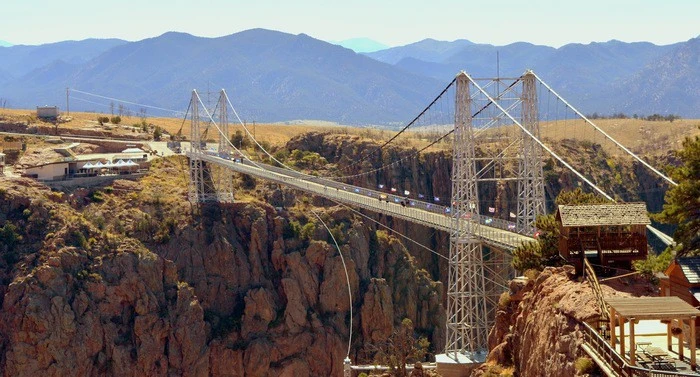
Until the completion of the Beipan River Guanxing Highway Bridge in 2003, the Royal Gorge Bridge in Colorado, USA, held the record as the world’s highest suspension bridge. The Royal Gorge Bridge spans the Arkansas River, which lies approximately 956 feet (291 meters) below the bridge deck.
The Beipan River Guanxing Highway Bridge, located near Huajiang town in Guizhou Province, China, stands at an astonishing height of 366 meters (1,201 feet) above the Beipan River. When it opened, it became the highest suspension bridge in the world, surpassing the Royal Gorge Bridge after 74 years. The Guanxing Bridge is part of an extensive highway facilitating transport through mountainous terrain.
The Royal Gorge Bridge remains a popular tourist attraction known for its dizzying height and spectacular views. Since opening, various companies have capitalized on its dramatic setting by adding attractions such as a zip line, a sky coaster ride, and gondolas, turning visitors’ fear of heights into thrilling experiences.
The Guanxing Bridge, while no longer the world’s highest, is still among the tallest bridges globally, situated in a region with several other record-breaking high bridges crossing the Beipan River valley.
5. Seven Mile Bridge, Florida

The Seven Mile Bridge, a well-known landmark in the Florida Keys, spans approximately 6.79 miles (10.93 kilometers), making it one of the longest bridges in the world extending over open ocean waters. It connects Knight’s Key in the Middle Keys to Little Duck Key in the Lower Keys. The bridge is a two-lane causeway, with one lane in each direction, and rises to a height of about 65 feet (20 meters) in certain sections to allow marine traffic to pass underneath.
The current bridge, completed in 1982, replaced an older bridge originally built as part of Henry Flagler’s Florida East Coast Railway in the early 1900s. The old bridge, which rested closer to the water and included a swing span for boat passage, was damaged by hurricanes and was eventually decommissioned. Much of the original bridge remains and is utilized as fishing piers and pedestrian access, although it has been closed in many parts due to deterioration from saltwater and storms.
Although the bridge does not pose major safety risks under normal conditions, its location makes it vulnerable to the Florida Keys’ frequent hurricanes, which can cause significant damage. The Seven Mile Bridge has also been featured in several movies and television shows, adding to its fame and cultural significance.
4. Capilano Suspension Bridge, Canada

The Capilano Suspension Bridge is a popular and iconic pedestrian bridge located in North Vancouver, British Columbia, Canada. It spans the Capilano River with a length of approximately 140 meters (460 feet) and hangs about 70 meters (230 feet) above the river below. The bridge sways noticeably, which can be unnerving for some, but it offers spectacular views of the surrounding temperate rainforest and canyon.
First built in 1889, the bridge was originally made of hemp ropes and cedar planks but has since been replaced and upgraded with steel cables and modern materials to ensure visitor safety. It is part of a private park that attracts over 1.2 million visitors annually. The park also features other nature attractions such as treetop walkways and a cliffside walk.
Contrary to some misconceptions, the bridge is well maintained, and no significant fatalities have been reported. Visitors are advised that those with a fear of heights or vertigo may find crossing the bridge challenging due to its height and swaying motion, but it remains one of Vancouver’s most celebrated natural attractions.
3. Langkawi Sky Bridge, Malaysia

The Langkawi Sky Bridge is a stunning curved pedestrian cable-stayed bridge located at an elevation of 660 meters (2,170 feet) above sea level on the peak of Gunung Mat Cincang, Langkawi, Malaysia. The bridge deck stretches 125 meters (410 feet) and curves gracefully around a single 81.5-meter-high pylon, hanging approximately 100 meters (328 feet) above the ground below.
Visitors typically reach the bridge via the Langkawi Cable Car, which takes them to the top station near the bridge. An inclined lift called the SkyGlide transports guests from the terminal station down to the bridge itself. The bridge’s design maximizes panoramic views of the surrounding rainforest and the Telaga Tujuh Waterfalls along the route to the peak.
Constructed in 2004 and opened in 2005, the entire structure was prefabricated and assembled in place with the help of Russian Kamov helicopters. The bridge underwent a major closure for maintenance and upgrades between 2012 and 2015, after which it fully reopened to visitors. Despite its height, the bridge is safe to cross, featuring steel railings and wire mesh sides, though visitors with a fear of heights may still find it intimidating. The Langkawi Sky Bridge offers a thrilling and unforgettable experience with breathtaking views of the Malaysian rainforest.
2. Hussaini hanging Bridge, Pakistan
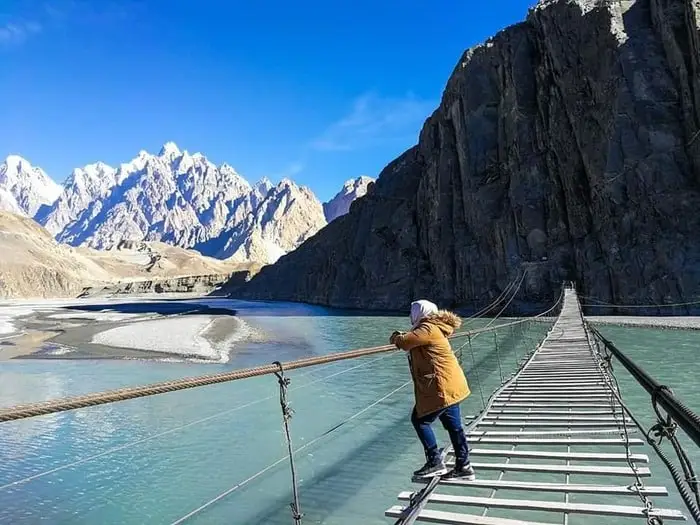
The Hussaini Hanging Bridge in the Gilgit-Baltistan region of northern Pakistan is considered one of the most precarious and thrilling rope bridges in the Himalayas. Spanning approximately 660 feet (200 meters) across the Hunza River, it hangs about 50 feet (15 meters) above the river’s surface. The bridge is constructed from spaced wooden planks supported by multiple steel cables, creating wide gaps between the planks that allow hikers to see the river rushing far below. Strong winds frequently sway the bridge, adding to its intimidating reputation.
Originally built around 1968 to connect the villages of Hussaini and Zarabad, the bridge has been reconstructed several times after damage from floods and deterioration. Remnants of the old bridge’s broken planks and cables still lie scattered near the current structure, serving as a reminder of the bridge’s turbulent history.
Crossing the Hussaini Hanging Bridge is a nerve-testing challenge for both locals and tourists alike. It has become a popular attraction for adventure seekers who cautiously shuffle across while taking in spectacular views of the surrounding Karakoram Mountains and nearby glaciers. Due to its age and natural wear, the bridge requires careful maintenance, and crossing it demands respect for the natural elements and the bridge’s precarious condition.
Though there have been few reported accidents, the bridge’s extreme exposure and fragile construction mean that crossing carries inherent risks, making it essential for visitors to exercise caution and follow safety guidelines while experiencing this iconic suspension bridge in Pakistan.
1. Deception Pass Bridge, Washington
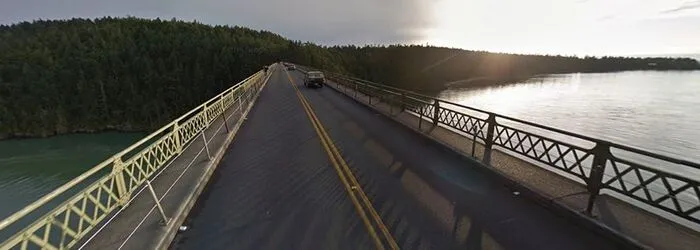
The Deception Pass Bridge, located in Washington state’s Deception Pass State Park, connects Whidbey Island to Fidalgo Island. The two-lane steel cantilever bridge stands about 180 feet (55 meters) above the swirling waters of Puget Sound, depending on tide levels. Spanning approximately 1,487 feet (453 meters) in total length, the bridge is a significant architectural and engineering landmark in the region.
Driving across the bridge can be especially intimidating on foggy days when visibility is poor, enhancing the dramatic views of the rushing water below. The bridge also features narrow sidewalks along both sides for pedestrians. Walking on the bridge’s pedestrian lane, which closely borders the edge, can increase the thrill and anxiety for those uneasy with heights or moving water.
Built in 1935, the bridge has become one of the most photographed and visited sites in Washington, attracting millions of visitors annually. Its combination of rugged natural beauty and historic design makes crossing the Deception Pass Bridge a memorable experience for drivers, hikers, and tourists alike.
The world’s most dangerous bridges remind us that travel isn’t always about comfort—it can also be about confronting fear and embracing adventure. Whether it’s the historic Puente de Ojuela in Mexico, the swaying Trift Bridge in Switzerland, or the high-canopy walkways of Kakum National Park in Ghana, these structures symbolize resilience, ingenuity, and the human will to cross even the most treacherous landscapes. For some, they remain vital routes of daily life; for others, they offer an unforgettable test of nerve. Each bridge is a stark reminder that danger and beauty often go hand in hand in the pursuit of connection.
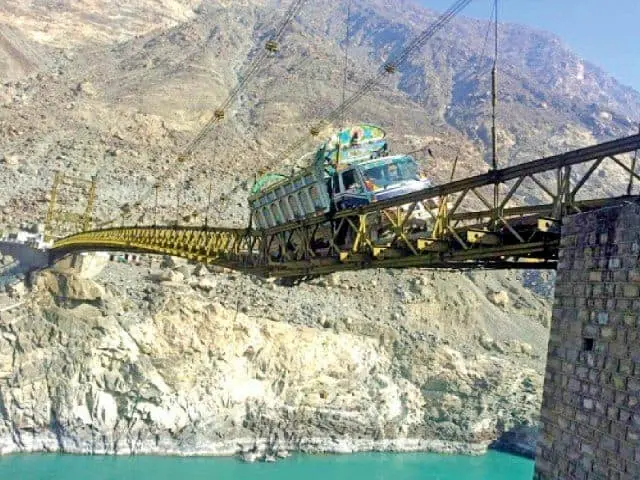
Thanks